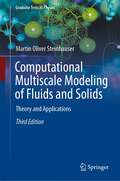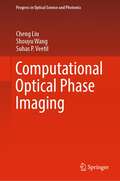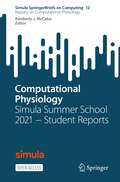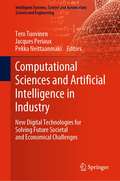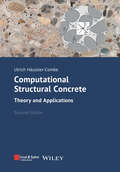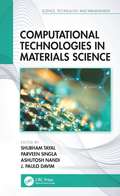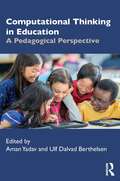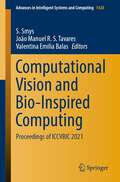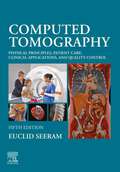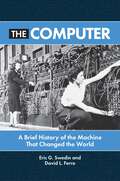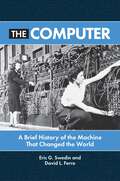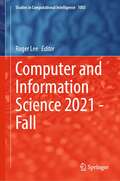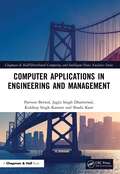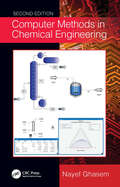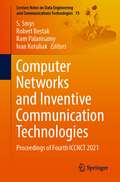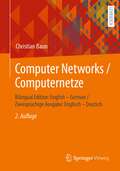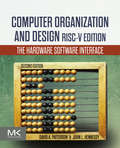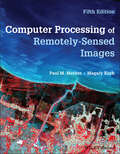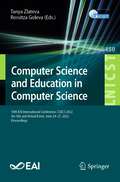- Table View
- List View
Computational Multiscale Modeling of Fluids and Solids: Theory and Applications (Graduate Texts in Physics)
by Martin Oliver SteinhauserThe expanded 3rd edition of this established textbook offers an updated overview and review of the computational physics techniques used in materials modelling over different length and time scales. It describes in detail the theory and application of some of the most important methods used to simulate materials across the various levels of spatial and temporal resolution. Quantum mechanical methods such as the Hartree-Fock approximation for solving the Schrödinger equation at the smallest spatial resolution are discussed as well as the Molecular Dynamics and Monte-Carlo methods on the micro- and meso-scale up to macroscopic methods used predominantly in the Engineering world such as Finite Elements (FE) or Smoothed Particle Hydrodynamics (SPH). Extensively updated throughout, this new edition includes additional sections on polymer theory, statistical physics and continuum theory, the latter being the basis of FE methods and SPH. Each chapter now first provides an overview of the key topics covered, with a new “key points” section at the end. The book is aimed at beginning or advanced graduate students who want to enter the field of computational science on multi-scales. It provides an in-depth overview of the basic physical, mathematical and numerical principles for modelling solids and fluids on the micro-, meso-, and macro-scale. With a set of exercises, selected solutions and several case studies, it is a suitable book for students in physics, engineering, and materials science, and a practical reference resource for those already using materials modelling and computational methods in their research.
Computational Optical Phase Imaging (Progress in Optical Science and Photonics #21)
by Cheng Liu Shouyu Wang Suhas P. VeetilIn this book, computational optical phase imaging techniques are presented along with Matlab codes that allow the reader to run their own simulations and gain a thorough understanding of the current state-of-the-art. The book focuses on modern applications of computational optical phase imaging in engineering measurements and biomedical imaging. Additionally, it discusses the future of computational optical phase imaging, especially in terms of system miniaturization and deep learning-based phase retrieval.
Computational Physiology: Simula Summer School 2021 − Student Reports (Simula SpringerBriefs on Computing #12)
This open access volume compiles student reports from the 2021 Simula Summer School in Computational Physiology. Interested readers will find herein a number of modern approaches to modeling excitable tissue. This should provide a framework for tools available to model subcellular and tissue-level physiology across scales and scientific questions. In June through August of 2021, Simula held the seventh annual Summer School in Computational Physiology in collaboration with the University of Oslo (UiO) and the University of California, San Diego (UCSD). The course focuses on modeling excitable tissues, with a special interest in cardiac physiology and neuroscience. The majority of the school consists of group research projects conducted by Masters and PhD students from around the world, and advised by scientists at Simula, UiO and UCSD. Each group then produced a report that addreses a specific problem of importance in physiology and presents a succinct summary of the findings. Reports may not necessarily represent new scientific results; rather, they can reproduce or supplement earlier computational studies or experimental findings. Reports from eight of the summer projects are included as separate chapters. The fields represented include cardiac geometry definition (Chapter 1), electrophysiology and pharmacology (Chapters 2–5), fluid mechanics in blood vessels (Chapter 6), cardiac calcium handling and mechanics (Chapter 7), and machine learning in cardiac electrophysiology (Chapter 8).
Computational Sciences and Artificial Intelligence in Industry: New Digital Technologies for Solving Future Societal and Economical Challenges (Intelligent Systems, Control and Automation: Science and Engineering #76)
by Tero Tuovinen Jacques Periaux Pekka NeittaanmäkiThis book is addressed to young researchers and engineers in the fields of Computational Science and Artificial Intelligence, ranging from innovative computational methods to digital machine learning tools and their coupling used for solving challenging industrial and societal problems.This book provides the latest knowledge from jointly academic and industries experts in Computational Science and Artificial Intelligence fields for exploring possibilities and identifying challenges of applying Computational Sciences and AI methods and tools in industrial and societal sectors.
Computational Structural Concrete: Theory and Applications
by Ulrich Haussler-CombeConcrete is by far the most used building material due to its advantages: it is shapeable, cost-effective and available everywhere. Combined with reinforcement it provides an immense bandwidth of properties and may be customized for a huge range of purposes. Thus, concrete is the building material of the 20th century. To be the building material of the 21th century its sustainability has to move into focus. Reinforced concrete structures have to be designed expending less material whereby their load carrying potential has to be fully utilized. Computational methods such as Finite Element Method (FEM) provide essential tools to reach the goal. In combination with experimental validation, they enable a deeper understanding of load carrying mechanisms. A more realistic estimation of ultimate and serviceability limit states can be reached compared to traditional approaches. This allows for a significantly improved utilization of construction materials and a broader horizon for innovative structural designs opens up. However, sophisticated computational methods are usually provided as black boxes. Data is fed in, the output is accepted as it is, but an understanding of the steps in between is often rudimentary. This has the risk of misinterpretations, not to say invalid results compared to initial problem definitions. The risk is in particular high for nonlinear problems. As a composite material, reinforced concrete exhibits nonlinear behaviour in its limit states, caused by interaction of concrete and reinforcement via bond and the nonlinear properties of the components. Its cracking is a regular behaviour. The book aims to make the mechanisms of reinforced concrete transparent from the perspective of numerical methods. In this way, black boxes should also become transparent. Appropriate methods are described for beams, plates, slabs and shells regarding quasi-statics and dynamics. Concrete creeping, temperature effects, prestressing, large displacements are treated as examples. State of the art concrete material models are presented. Both the opportunities and the pitfalls of numerical methods are shown. Theory is illustrated by a variety of examples. Most of them are performed with the ConFem software package implemented in Python and available under open-source conditions.
Computational Structural Concrete: Theory and Applications
by Ulrich Haussler-CombeConcrete is by far the most used building material due to its advantages: it is shapeable, cost-effective and available everywhere. Combined with reinforcement it provides an immense bandwidth of properties and may be customized for a huge range of purposes. Thus, concrete is the building material of the 20th century. To be the building material of the 21th century its sustainability has to move into focus. Reinforced concrete structures have to be designed expending less material whereby their load carrying potential has to be fully utilized. Computational methods such as Finite Element Method (FEM) provide essential tools to reach the goal. In combination with experimental validation, they enable a deeper understanding of load carrying mechanisms. A more realistic estimation of ultimate and serviceability limit states can be reached compared to traditional approaches. This allows for a significantly improved utilization of construction materials and a broader horizon for innovative structural designs opens up. However, sophisticated computational methods are usually provided as black boxes. Data is fed in, the output is accepted as it is, but an understanding of the steps in between is often rudimentary. This has the risk of misinterpretations, not to say invalid results compared to initial problem definitions. The risk is in particular high for nonlinear problems. As a composite material, reinforced concrete exhibits nonlinear behaviour in its limit states, caused by interaction of concrete and reinforcement via bond and the nonlinear properties of the components. Its cracking is a regular behaviour. The book aims to make the mechanisms of reinforced concrete transparent from the perspective of numerical methods. In this way, black boxes should also become transparent. Appropriate methods are described for beams, plates, slabs and shells regarding quasi-statics and dynamics. Concrete creeping, temperature effects, prestressing, large displacements are treated as examples. State of the art concrete material models are presented. Both the opportunities and the pitfalls of numerical methods are shown. Theory is illustrated by a variety of examples. Most of them are performed with the ConFem software package implemented in Python and available under open-source conditions.
Computational Technologies in Materials Science (Science, Technology, and Management)
by Shubham Tayal Parveen Singla Ashutosh Nandi J. Paulo DavimAdvanced materials are essential for economic security and human well-being, with applications in industries aimed at addressing challenges in clean energy, national security, and human welfare. Yet, it can take years to move a material to the market after its initial discovery. Computational techniques have accelerated the exploration and development of materials, offering the chance to move new materials to the market quickly. Computational Technologies in Materials Science addresses topics related to AI, machine learning, deep learning, and cloud computing in materials science. It explores characterization and fabrication of materials, machine-learning-based models, and computational intelligence for the synthesis and identification of materials. This book • Covers material testing and development using computational intelligence • Highlights the technologies to integrate computational intelligence and materials science • Details case studies and detailed applications • Investigates challenges in developing and using computational intelligence in materials science • Analyzes historic changes that are taking place in designing materials. This book encourages material researchers and academics to develop novel theories and sustainable computational techniques and explores the potential for computational intelligence to replace traditional materials research.
Computational Technologies in Materials Science (Science, Technology, and Management)
by Shubham Tayal Parveen Singla Ashutosh Nandi J. Paulo DavimAdvanced materials are essential for economic security and human well-being, with applications in industries aimed at addressing challenges in clean energy, national security, and human welfare. Yet, it can take years to move a material to the market after its initial discovery. Computational techniques have accelerated the exploration and development of materials, offering the chance to move new materials to the market quickly. Computational Technologies in Materials Science addresses topics related to AI, machine learning, deep learning, and cloud computing in materials science. It explores characterization and fabrication of materials, machine-learning-based models, and computational intelligence for the synthesis and identification of materials. This book • Covers material testing and development using computational intelligence • Highlights the technologies to integrate computational intelligence and materials science • Details case studies and detailed applications • Investigates challenges in developing and using computational intelligence in materials science • Analyzes historic changes that are taking place in designing materials. This book encourages material researchers and academics to develop novel theories and sustainable computational techniques and explores the potential for computational intelligence to replace traditional materials research.
Computational Thinking in Education: A Pedagogical Perspective
by Aman YadavComputational Thinking in Education explores the relevance of computational thinking in primary and secondary education. As today’s school-aged students prepare to live and work in a thoroughly digitized world, computer science is providing a wealth of new learning concepts and opportunities across domains. This book offers a comprehensive overview of computational thinking, its history, implications for equity and inclusion, analyses of competencies in practice, and integration into learning, instruction, and assessment through scaffolded teacher education. Computer science education faculty and pre- and in-service educators will find a fresh pedagogical approach to computational thinking in primary and secondary classrooms.
Computational Thinking in Education: A Pedagogical Perspective
by Aman Yadav Ulf Dalvad BerthelsenComputational Thinking in Education explores the relevance of computational thinking in primary and secondary education. As today’s school-aged students prepare to live and work in a thoroughly digitized world, computer science is providing a wealth of new learning concepts and opportunities across domains. This book offers a comprehensive overview of computational thinking, its history, implications for equity and inclusion, analyses of competencies in practice, and integration into learning, instruction, and assessment through scaffolded teacher education. Computer science education faculty and pre- and in-service educators will find a fresh pedagogical approach to computational thinking in primary and secondary classrooms.
Computational Vision and Bio-Inspired Computing: Proceedings of ICCVBIC 2021 (Advances in Intelligent Systems and Computing #1420)
by S. Smys João Manuel R. S. Tavares Valentina Emilia BalasThis book includes selected papers from the 5th International Conference on Computational Vision and Bio Inspired Computing (ICCVBIC 2021), held in Coimbatore, India, during November 25–26, 2021. This book presents state-of-the-art research innovations in computational vision and bio-inspired techniques. The book reveals the theoretical and practical aspects of bio-inspired computing techniques, like machine learning, sensor-based models, evolutionary optimization and big data modeling and management that make use of effectual computing processes in the bio-inspired systems. It also contributes to the novel research that focuses on developing bio-inspired computing solutions for various domains, such as human–computer interaction, image processing, sensor-based single processing, recommender systems and facial recognition, which play an indispensable part in smart agriculture, smart city, biomedical and business intelligence applications.
Computed Tomography - E-Book: Physical Principles, Patient Care, Clinical Applications, and Quality Control
by Euclid SeeramBuild the foundation necessary for the practice of CT scanning with Computed Tomography: Physical Principles, Patient Care, Clinical Applications, and Quality Control, 5th Edition. Written to meet the varied requirements of radiography students and practitioners, this two-color text provides comprehensive coverage of the physical principles of computed tomography and its clinical applications. The clear, straightforward approach is designed to improve your understanding of sectional anatomic images as they relate to computed tomography and facilitate communication between CT technologists and other medical personnel. Chapter outlines and chapter review questions help you focus your study time and master content. NEW! Three additional chapters reflect the latest industry CT standards in imaging: Radiation Awareness and Safety Campaigns in Computed Tomography, Patient Care Considerations, and Artificial Intelligence: An Overview of Applications in Health and Medical Imaging. UPDATED! More than 509 photos and line drawings visually clarify key concepts. UPDATED! The latest information keeps you up to date on advances in volume CT scanning; CT fluoroscopy; and multislice applications like 3-D imaging, CT angiography, and virtual reality imaging (endoscopy).
The Computer: A Brief History of the Machine That Changed the World
by Eric G. Swedin David L. FerroThis book, aimed at general readers, covers the entirety of computing history from antiquity to the present, placing the story of computing into the broader context of politics, economics, society, and more.Computers dominate the world we live in, and this book describes how we got here. The Computer: A Brief History of the Machine That Changed the World covers topics from early efforts at mathematical computation back in ancient times, such as the abacus and the Antikythera device, through Babbage's Difference Engine and the Hollerith Tabulating Machines of the 19th century, to the eventual invention of the modern computer during World War II and its aftermath. The scope of the text reaches into the modern day, with chapters on social media and the influence of computers and technology on recent elections.The information in this book, perfect for readers new to the topic or those looking to delve into the history of computers in greater detail, can be accessed both chronologically and topically. With chapters focusing on larger time periods as well as shorter subsections covering specific people and topics, this book is designed to make the history of computing as approachable as possible.
The Computer: A Brief History of the Machine That Changed the World
by Eric G. Swedin David L. FerroThis book, aimed at general readers, covers the entirety of computing history from antiquity to the present, placing the story of computing into the broader context of politics, economics, society, and more.Computers dominate the world we live in, and this book describes how we got here. The Computer: A Brief History of the Machine That Changed the World covers topics from early efforts at mathematical computation back in ancient times, such as the abacus and the Antikythera device, through Babbage's Difference Engine and the Hollerith Tabulating Machines of the 19th century, to the eventual invention of the modern computer during World War II and its aftermath. The scope of the text reaches into the modern day, with chapters on social media and the influence of computers and technology on recent elections.The information in this book, perfect for readers new to the topic or those looking to delve into the history of computers in greater detail, can be accessed both chronologically and topically. With chapters focusing on larger time periods as well as shorter subsections covering specific people and topics, this book is designed to make the history of computing as approachable as possible.
Computer and Information Science 2021 - Fall (Studies in Computational Intelligence #1003)
by Roger LeeThis edited book presents scientific results of the 21th IEEE/ACIS International Fall Virtual Conference on Computer and Information Science (ICIS 2021-Fall) held on October 13-15, 2021, in Xi’an China. The aim of this conference was to bring together researchers and scientists, businessmen and entrepreneurs, teachers, engineers, computer users, and students to discuss the numerous fields of computer science and to share their experiences and exchange new ideas and information in a meaningful way. Research results about all aspects (theory, applications, and tools) of computer and information science and to discuss the practical challenges encountered along the way and the solutions adopted to solve them.The conference organizers selected the best papers from those papers accepted for presentation at the conference. The papers were chosen based on review scores submitted by members of the program committee and underwent further rigorous rounds of review. From this second round of review, 13 of the conference’s most promising papers are then published in this Springer (SCI) book and not the conference proceedings. We impatiently await the important contributions that we know these authors will bring to the field of computer and information science.
Computer Applications in Engineering and Management (Chapman & Hall/Distributed Computing and Intelligent Data Analytics Series)
by Parveen BerwalThe book Computer Applications in Engineering and Management is about computer applications in management, electrical engineering, electronics engineering, and civil engineering. It covers the software tools for office automation, introduces the basic concepts of database management, and provides an overview about the concepts of data communication, internet, and e-commerce. Additionally, the book explains the principles of computing management used in construction of buildings in civil engineering and the role of computers in power grid automation in electronics engineering. Features Provides an insight to prospective research and application areas related to industry and technology Includes industry-based inputs Provides a hands-on approach for readers of the book to practice and assimilate learning This book is primarily aimed at undergraduates and graduates in computer science, information technology, civil engineering, electronics and electrical engineering, management, academicians, and research scholars.
Computer Applications in Engineering and Management (Chapman & Hall/Distributed Computing and Intelligent Data Analytics Series)
by Parveen Berwal Jagjit Singh Dhatterwal Kuldeep Singh Kaswan Shashi KantThe book Computer Applications in Engineering and Management is about computer applications in management, electrical engineering, electronics engineering, and civil engineering. It covers the software tools for office automation, introduces the basic concepts of database management, and provides an overview about the concepts of data communication, internet, and e-commerce. Additionally, the book explains the principles of computing management used in construction of buildings in civil engineering and the role of computers in power grid automation in electronics engineering. Features Provides an insight to prospective research and application areas related to industry and technology Includes industry-based inputs Provides a hands-on approach for readers of the book to practice and assimilate learning This book is primarily aimed at undergraduates and graduates in computer science, information technology, civil engineering, electronics and electrical engineering, management, academicians, and research scholars.
Computer Methods in Chemical Engineering
by Nayef GhasemWhile various software packages have become essential for performing unit operations and other kinds of processes in chemical engineering, the fundamental theory and methods of calculation must also be understood to effectively test the validity of these packages and verify the results. Computer Methods in Chemical Engineering, Second Edition presents the most used simulation software along with the theory involved. It covers chemical engineering thermodynamics, fluid mechanics, material and energy balances, mass transfer operations, reactor design, and computer applications in chemical engineering. The highly anticipated Second Edition is thoroughly updated to reflect the latest updates in the featured software and has added a focus on real reactors, introduces AVEVA Process Simulation software, and includes new and updated appendixes. Through this book, students will learn the following: What chemical engineers do The functions and theoretical background of basic chemical engineering unit operations How to simulate chemical processes using software packages How to size chemical process units manually and with software How to fit experimental data How to solve linear and nonlinear algebraic equations as well as ordinary differential equations Along with exercises and references, each chapter contains a theoretical description of process units followed by numerous examples that are solved step by step via hand calculation and computer simulation using Hysys/UniSim, PRO/II, Aspen Plus, and SuperPro Designer. Adhering to the Accreditation Board for Engineering and Technology (ABET) criteria, the book gives chemical engineering students and professionals the tools to solve real problems involving thermodynamics and fluid-phase equilibria, fluid flow, material and energy balances, heat exchangers, reactor design, distillation, absorption, and liquid extraction. This new edition includes many examples simulated by recent software packages. In addition, fluid package information is introduced in correlation to the numerical problems in book. An updated solutions manual and PowerPoint slides are also provided in addition to new video guides and UniSim program files.
Computer Methods in Chemical Engineering
by Nayef GhasemWhile various software packages have become essential for performing unit operations and other kinds of processes in chemical engineering, the fundamental theory and methods of calculation must also be understood to effectively test the validity of these packages and verify the results. Computer Methods in Chemical Engineering, Second Edition presents the most used simulation software along with the theory involved. It covers chemical engineering thermodynamics, fluid mechanics, material and energy balances, mass transfer operations, reactor design, and computer applications in chemical engineering. The highly anticipated Second Edition is thoroughly updated to reflect the latest updates in the featured software and has added a focus on real reactors, introduces AVEVA Process Simulation software, and includes new and updated appendixes. Through this book, students will learn the following: What chemical engineers do The functions and theoretical background of basic chemical engineering unit operations How to simulate chemical processes using software packages How to size chemical process units manually and with software How to fit experimental data How to solve linear and nonlinear algebraic equations as well as ordinary differential equations Along with exercises and references, each chapter contains a theoretical description of process units followed by numerous examples that are solved step by step via hand calculation and computer simulation using Hysys/UniSim, PRO/II, Aspen Plus, and SuperPro Designer. Adhering to the Accreditation Board for Engineering and Technology (ABET) criteria, the book gives chemical engineering students and professionals the tools to solve real problems involving thermodynamics and fluid-phase equilibria, fluid flow, material and energy balances, heat exchangers, reactor design, distillation, absorption, and liquid extraction. This new edition includes many examples simulated by recent software packages. In addition, fluid package information is introduced in correlation to the numerical problems in book. An updated solutions manual and PowerPoint slides are also provided in addition to new video guides and UniSim program files.
Computer Networks and Inventive Communication Technologies: Proceedings of Fourth ICCNCT 2021 (Lecture Notes on Data Engineering and Communications Technologies #75)
by S. Smys Robert Bestak Ram Palanisamy Ivan KotuliakThis book is a collection of peer-reviewed best-selected research papers presented at 4th International Conference on Computer Networks and Inventive Communication Technologies (ICCNCT 2021). The book covers new results in theory, methodology, and applications of computer networks and data communications. It includes original papers on computer networks, network protocols and wireless networks, data communication technologies, and network security. The proceedings of this conference are a valuable resource, dealing with both the important core and the specialized issues in the areas of next-generation wireless network design, control, and management, as well as in the areas of protection, assurance, and trust in information security practice. It is a reference for researchers, instructors, students, scientists, engineers, managers, and industry practitioners for advanced work in the area.
Computer Networks / Computernetze: Bilingual Edition: English – German / Zweisprachige Ausgabe: Englisch – Deutsch
by Christian BaunMit diesem Buch erlangen Sie Grundlagenwissen im Bereich der ComputernetzwerkeDieses Buch bietet Ihnen einen kompakten Überblick über das Thema Computernetzwerke. Sein Aufbau orientiert sich an den Schichten der etablierten Referenzmodelle und behandelt für jede Schicht die Geräte und die wichtigsten Protokolle. Zu den Protokollen gehören auch Netzwerktechnologien wie Ethernet, WLAN, Bluetooth usw. und die Übertragungsmedien.Das Ziel des Buches ist es nicht, eine Auflistung von Algorithmen zu schaffen, sondern eine an der Realität orientierte Beschreibung zu liefern, die die wichtigsten Technologien in einem klaren Zusammenhang behandelt. Das Buch soll dem Leser ein fundiertes Verständnis von Computernetzwerken in kompakter Form vermitteln.Das Besondere dabei ist die zweisprachige Darstellung des Inhalts. In zwei Spalten stehen der deutsche und der englische Text nebeneinander, so dass der Leser gleichzeitig seine Sprachkenntnisse und sein Fachvokabular verbessern kann. Das Buch richtet sich vor allem an Studierende der Informatik und an alle am Thema Interessierten. Diese Inhalte vermittelt der Autor dem LeserChristian Baun vermittelt dem Leser in seinem Buch alle wichtigen Grundlagen der Computernetzwerke. Dazu gehören unter anderen:· Grundlagen der Informations- und Netzwerktechnik· Grundlagen der Computervernetzung· Protokolle und Protokollschichten· Bitübertragungsschicht· Sicherungsschicht· Vermittlungsschicht· Transportschicht· Anwendungsschicht· Netzwerkvirtualisierung· Funktionsweise des OSI-Referenzmodells· Kommandozeilenwerkzeuge Mithilfe dieser Inhalte erhält der Leser einen kompakten Einblick in die Thematik.---This book presents a compact, yet detailed overview and introduction to computer networks and their components. The book is written in both English and German, arranged in side-by-side columns. This feature helps readers improve and broaden their language skills, and gain familiarity with the specialized vocabulary of computer science and networking at the same time. The book opens with a review of computer science basics, including the building blocks of data, file and storage dimensions, and Unicode. The fundamentals of computer networking are presented, with sections on the dimensions of different types of networks, data transmission, and media access control. Protocols and reference models are explained, followed by chapters on the functional layers of networks: Physical Layer, Data Link Layer, Network Layer, Transport Layer, and Application Layer. Additional topics covered include:· Computer network topologies· Bandwidth and latency· Network virtualization The book includes a collection of command line tools for network configuration and for analyzing network-related issues. The book concludes with a list of technical terms, and an extensive glossary, both presented in side-by-side columns, in English and German. Requiring little to no technical background, Computer Networks – Computernetze benefits college-level students interested in computer science. It is especially useful for students and working professionals who wish to improve their knowledge of
Computer Organization and Design RISC-V Edition: The Hardware Software Interface (ISSN)
by David A. Patterson John L. HennessyComputer Organization and Design RISC-V Edition: The Hardware Software Interface, Second Edition, the award-winning textbook from Patterson and Hennessy that is used by more than 40,000 students per year, continues to present the most comprehensive and readable introduction to this core computer science topic. This version of the book features the RISC-V open source instruction set architecture, the first open source architecture designed for use in modern computing environments such as cloud computing, mobile devices, and other embedded systems. Readers will enjoy an online companion website that provides advanced content for further study, appendices, glossary, references, links to software tools, and more.Covers parallelism in-depth, with examples and content highlighting parallel hardware and software topicsFocuses on 64-bit address, ISA to 32-bit address, and ISA for RISC-V because 32-bit RISC-V ISA is simpler to explain, and 32-bit address computers are still best for applications like embedded computing and IoTIncludes new sections in each chapter on Domain Specific Architectures (DSA)Provides updates on all the real-world examples in the book
Computer Processing of Remotely-Sensed Images
by Paul M. Mather Magaly KochComputer Processing of Remotely-Sensed Images A thorough introduction to computer processing of remotely-sensed images, processing methods, and applications Remote sensing is a crucial form of measurement that allows for the gauging of an object or space without direct physical contact, allowing for the assessment and recording of a target under conditions which would normally render access difficult or impossible. This is done through the analysis and interpretation of electromagnetic radiation (EMR) that is reflected or emitted by an object, surveyed and recorded by an observer or instrument that is not in contact with the target. This methodology is particularly of importance in Earth observation by remote sensing, wherein airborne or satellite-borne instruments of EMR provide data on the planet’s land, seas, ice, and atmosphere. This permits scientists to establish relationships between the measurements and the nature and distribution of phenomena on the Earth’s surface or within the atmosphere. Still relying on a visual and conceptual approach to the material, the fifth edition of this successful textbook provides students with methods of computer processing of remotely sensed data and introduces them to environmental applications which make use of remotely-sensed images. The new edition’s content has been rearranged to be more clearly focused on image processing methods and applications in remote sensing with new examples, including material on the Copernicus missions, microsatellites and recently launched SAR satellites, as well as time series analysis methods. The fifth edition of Computer Processing of Remotely-Sensed Images also contains: A cohesive presentation of the fundamental components of Earth observation remote sensing that is easy to understand and highly digestible Largely non-technical language providing insights into more advanced topics that may be too difficult for a non-mathematician to understand Illustrations and example boxes throughout the book to illustrate concepts, as well as revised examples that reflect the latest information References and links to the most up-to-date online and open access sources used by students Computer Processing of Remotely-Sensed Images is a highly insightful textbook for advanced undergraduates and postgraduate students taking courses in remote sensing and GIS in Geography, Geology, and Earth & Environmental Science departments.
Computer Processing of Remotely-Sensed Images: An Introduction
by Paul M. Mather Magaly KochComputer Processing of Remotely-Sensed Images A thorough introduction to computer processing of remotely-sensed images, processing methods, and applications Remote sensing is a crucial form of measurement that allows for the gauging of an object or space without direct physical contact, allowing for the assessment and recording of a target under conditions which would normally render access difficult or impossible. This is done through the analysis and interpretation of electromagnetic radiation (EMR) that is reflected or emitted by an object, surveyed and recorded by an observer or instrument that is not in contact with the target. This methodology is particularly of importance in Earth observation by remote sensing, wherein airborne or satellite-borne instruments of EMR provide data on the planet’s land, seas, ice, and atmosphere. This permits scientists to establish relationships between the measurements and the nature and distribution of phenomena on the Earth’s surface or within the atmosphere. Still relying on a visual and conceptual approach to the material, the fifth edition of this successful textbook provides students with methods of computer processing of remotely sensed data and introduces them to environmental applications which make use of remotely-sensed images. The new edition’s content has been rearranged to be more clearly focused on image processing methods and applications in remote sensing with new examples, including material on the Copernicus missions, microsatellites and recently launched SAR satellites, as well as time series analysis methods. The fifth edition of Computer Processing of Remotely-Sensed Images also contains: A cohesive presentation of the fundamental components of Earth observation remote sensing that is easy to understand and highly digestible Largely non-technical language providing insights into more advanced topics that may be too difficult for a non-mathematician to understand Illustrations and example boxes throughout the book to illustrate concepts, as well as revised examples that reflect the latest information References and links to the most up-to-date online and open access sources used by students Computer Processing of Remotely-Sensed Images is a highly insightful textbook for advanced undergraduates and postgraduate students taking courses in remote sensing and GIS in Geography, Geology, and Earth & Environmental Science departments.
Computer Science and Education in Computer Science: 18th EAI International Conference, CSECS 2022, On-Site and Virtual Event, June 24-27, 2022, Proceedings (Lecture Notes of the Institute for Computer Sciences, Social Informatics and Telecommunications Engineering #450)
by Tanya Zlateva Rossitza GolevaThis book constitutes the refereed post-conference proceedings of the 18th EAI International Conference on Computer Science and Education in Computer Science, CSECS 2022, held in June 2022 in Sofia, Bulgaria. Due to COVID-19 pandemic the conference was held On-Site and virtually.The 15 full papers and 9 short papers were carefully reviewed and selected from 53 submissions. The papers present are grouped into 2 tracks, i.e., computer science implementations and education in computer science. CSECS conference presents research in software engineering and information systems design, cryptography, the theoretical foundation of the algorithms, and implementation of machine learning and big data technologies. Another important topic of the conference is the education in computer science which includes the introduction and evaluation of computing programs, curricula, and online courses, to syllabus, laboratories, teaching, and pedagogy aspects. The technical and education topics evolved multiple existing and emerging technologies, solutions, and services for design and training providing a heterogeneous approach towards delivering Software 4.0 and Education 4.0 to a broad range of citizens and societies.
